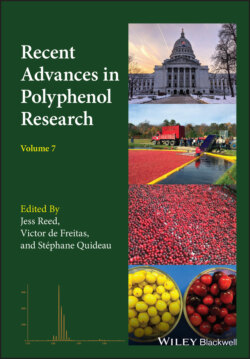Читать книгу Recent Advances in Polyphenol Research - Группа авторов - Страница 2
Table of Contents
Оглавление1 Cover
2 Series Page
3 Title Page
4 Copyright Page
5 Contributors
6 Preface
7 Acknowledgements
8 1 Achieving Complexity at the Bottom Through the Flavylium Cation‐Based Multistate 1.1 Introduction 1.2 Flavylium Cation as a Metamorphosis Generator 1.3 Extending the Multistate of Anthocyanins and Related Compounds to the Basic Region 1.4 The Kinetic Processes 1.5 Conclusions and Perspectives References
9 2 Proanthocyanidin Oligomers with Doubly Linked (A‐Type) Interflavan Connectivity 2.1 Introduction 2.2 Structure 2.3 Synthetic Studies 2.4 Conclusion References
10 3 Answering the Call of the Wild: Polyphenols in Traditional Therapeutic Practice 3.1 Introduction 3.2 The Wildcrafting Tradition 3.3 How Wildcrafted Edible Plants Differ from Agricultural Commodities 3.4 Animal Mimickry/Zoopharmacognosy 3.5 Probing the Mechanisms Behind Polyphenol‐rich Traditional Medicines Bioactivity 3.6 Commercialization Prospects for Wildcrafted Polyphenol‐rich Plants 3.7 Acknowledgements References
11 4 Causes and Consequences of Condensed Tannin Variation in Populus 4.1 Introduction 4.2 Condensed Tannin Biosynthesis 4.3 Allocational Tradeoffs Influence CT Production 4.4 Causes of Quantitative and Qualitative Variation in Populus CTs 4.5 Roles of CT Variation in Populus‐Environment Interactions 4.6 Importance of CTs in Populus‐dominated Ecosystems of the Anthropocene 4.7 Conclusions and Challenges 4.8 Acknowledgements References
12 5 Matrix‐Assisted Laser Desorption/Ionization Time‐of‐Flight Mass Spectrometry (MALDI‐TOF MS) of Proanthocyanidins to Determine Authenticity of Functional Foods and Dietary Supplements 5.1 Introduction 5.2 Introduction to Matrix‐Assisted Laser Desorption/Ionization Time‐of‐Flight Mass Spectrometry (MALDI‐TOF MS) 5.3 Mass Spectrometry of Proanthocyanidins 5.4 Deconvolution of Isotope Patterns of A‐ to B‐type Interflavan Bonds in Proanthocyanidins 5.5 Multivariate Analysis of MALDI‐TOF MS Spectra Data 5.6 Conclusion References
13 6 Challenges in Analyzing Bioactive Proanthocyanidins 6.1 Introduction 6.2 Structural Diversity of Proanthocyanidins 6.3 Noted Challenges in Proanthocyanidin Analysis 6.4 Fate of Proanthocyanidins in the Digestive Tract and During Plant Fermentation 6.5 Definition and Possible Origins of Nonextractable Proanthocyanidins (NEPAs) 6.6 Universal Problems of Proanthocyanidin Analysis 6.7 Proanthocyanidin Characterization by Depolymerization 6.8 Mass Spectrometry 6.9 Nuclear Magnetic Resonance Spectroscopy 6.10 Colorimetry 6.11 Infrared Spectroscopy 6.12 Conclusions 6.13 Acknowledgments References
14 7 Lignin Monomers Derived from the Flavonoid and Hydroxystilbene Biosynthetic Pathways 7.1 Lignin Monomers Derived from the Monolignol Biosynthetic Pathway 7.2 Flavonoid and Hydroxystilbene Biosynthetic Pathways 7.3 Radical Coupling of Flavonoids and Hydroxystilbenes with Monolignols – Flavonolignans and Stilbenolignans 7.4 Lignin Monomers Derived from the Flavonoid and Hydroxystilbene Biosynthetic Pathways 7.5 Conclusions and Future Prospects 7.6 Acknowledgments References
15 8 Complex Regulation of Proanthocyanidin Biosynthesis in Plants by R2R3 MYB Activators and Repressors 8.1 Introduction to PAs and Flavan‐3‐ols 8.2 Regulation of PA and Flavonoid Biosynthesis by MYB Transcription Factors 8.3 The Importance of Repressor MYBs in PA and Flavonoid Metabolism 8.4 The Complex Interaction of PA MYB Activators, MYB Repressors, and bHLH Transcription Factors 8.5 Developmental and Plant Hormone‐Mediated Regulation of the PA Pathway via MYBs 8.6 Stress Activation of PA Synthesis by MYBs in Poplar and Other Woody Plants 8.7 Summary and Conclusions 8.8 Acknowledgments References
16 9 Conservation and Divergence Between Bryophytes and Angiosperms in the Biosynthesis and Regulation of Flavonoid Production 9.1 Introduction 9.2 Flavonoid Biosynthesis in Basal Plants 9.3 Origins of the Phenylpropanoid Biosynthetic Pathway and Conservation Across the Embryophytes 9.4 Notable Phenylpropanoids of Bryophytes 9.5 Regulation of Flavonoid Production 9.6 Concluding Remarks 9.7 Acknowledgements References
17 10 Matching Proanthocyanidin Use with Appropriate Analytical Method 10.1 Introduction 10.2 General Proanthocyanidin Structure and Analysis 10.3 Red Wine Mouthfeel 10.4 Biological Activity 10.5 Summary References
18 11 Imaging Polyphenolic Compounds in Plant Tissues 11.1 Introduction 11.2 The Chemical Nature and Intrinsic Fluorescence Properties of Polyphenols 11.3 Microscopy‐based Methods for Imaging Plant Phenolic Compounds 11.4 Polyphenols and Microscopy Imaging 11.5 Future Challenges and Opportunities in Imaging Plant Metabolites 11.6 Acknowledgments References
19 Index
20 End User License Agreement
